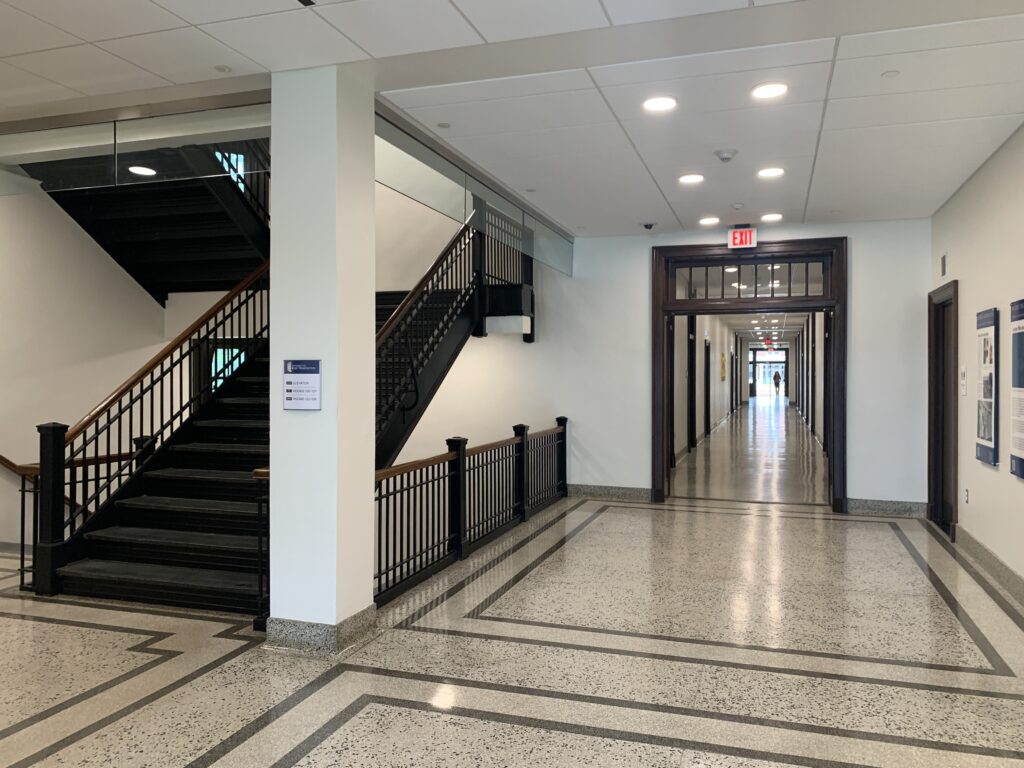Freshmen face challenges moving into newly-renovated Virginia Hall
4 min read
Some freshmen Virginia Hall residents have experienced problems with the building’s new technology. | Emily Warren / The Blue & Gray Press
by ABIGAIL SLAUGHTER
Staff Writer
The university welcomed freshmen into Virginia Hall on Aug. 18 after the completion of its two-year renovation. The residence hall has updated technology and is the first building on campus to use EagleOne entry for dorm rooms instead of keys, but some have not been working correctly.
Freshman Merna Mousa and her roommate, freshman Deanna Fortney, have had to use a traditional brass key instead of their EagleOnes to enter their room.
Mousa was once locked out at 2 a.m. because the sensor would not unlock her door.
“I feel like if they do fix it, I’ll be so afraid to go without my actual key just in case it doesn’t work,” said Fortney.
In addition to a faulty door sensor, every night between approximately 2 a.m. and 7:30 a.m. without fail, their overhead light turns on and wakes them up.
The hall’s approximately 180 first-year students moved into the second oldest residence hall on campus and were welcomed by both the building’s historic brick façade and brand-new interior.
Mousa is part of the first class of students to be back living in the historic building.
“I like how the rooms are really big here,” said Mousa. “There’s a lot of space.”
The building has been completely renovated for UMW’s 2021 freshman class and beyond. Virginia Hall is equipped with new technology and new perks. Each individual room has its own hidden heating and cooling unit, and the building has new hangout spaces and an updated kitchen, among other improvements.
Virginia Hall also now has keyless-entry, meaning that students enter all doors—including the doors leading into their rooms—with their EagleOnes. This residence hall is the first building on campus to see this technology, which caught the attention of other students.
Jules Yerovi, a senior environmental science major, lived on the third floor of Virginia Hall during the 2018-2019 academic year, long before keyless entry had existed anywhere on campus.
“I guess it’s kinda easy; you don’t have to print keys for people,” said Yerovi. “You just give them access. New buildings equal better security, usually.”
Sam Biggers, a 2016 UMW alum and historic preservation major, was the project engineer for Kjellstrom & Lee Construction, a general contractor based in the state of Virginia who led the renovation of Virginia Hall over the last two years.
According to Biggers, keyless entry is difficult to do from a technical standpoint, but he thinks keyless entry will be implemented in other buildings on campus in the future as other renovations happen.
“It sounds like that’s the way things are moving, probably not just on this campus but on other campuses too,” said Biggers.
In order to keep the historic look of the dorm’s façade, Biggers had to consider which elements of the original building to keep intact.
“This renovation was unique in a lot of ways because it tried to keep as much—it’s what historic preservationists call original fabric—as possible,” said Biggers. “That was a big challenge, but I think it was also a huge success and kept Virginia’s character intact while updating it at the same time.”
The dorm was built in three sections over a period of 20 years, meaning that each of them had different construction types. Because of discrepancies between the construction types of these sections, Biggers and the rest of the Kjellstrom & Lee team had to work with all different ceiling heights and different wood trim around doors and windows, all while trying to keep the historic feel of the building intact.
This meant leaving old trim and plaster patched in with the new, all while trying to make where both meet as seamless as possible.
“I’d say probably one of the consistent challenges we had was making our new work—the stuff we put in—match and not stick out like a sore thumb with the old stuff,” said Biggers.
The renovation process began in May of 2019 when students moved out and Kjellstrom & Lee did a preliminary investigation to give to the architect and the design team so they could sketch out project drawings. After finishing their investigation, Virginia Hall students of the 2019-2020 academic year were then moved into Willard Hall during winter break so that the demolition process could begin.
Construction on this dorm began during the month of April 2020, shortly after students were sent home due to the pandemic. According to Biggers, construction was completed on time in August, as the original goal was to have the dorm open for freshmen by the start of the 2021 semester.


